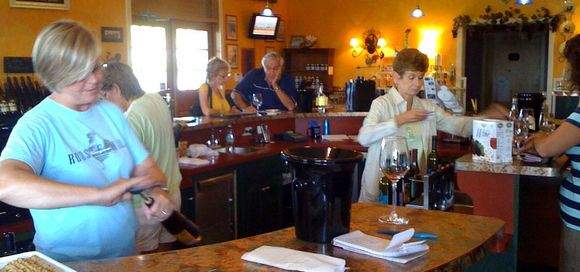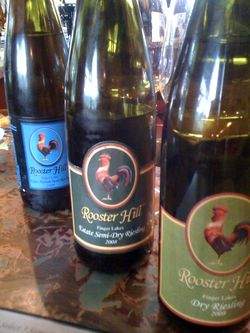
By Evan Dawson, Finger Lakes and Managing Editor
Photo: Owner Amy Hoffman, left, works the tasting room on a busy summer day
There are not many 90-point Gewurztraminers that have come out of the Finger Lakes, and there has never been a 90-point lemberger.
Amy Hoffman, owner of Rooster Hill Vineyards on Keuka Lake, believes she has one of each. And she isn't afraid to say so.
"I jumped right on Facebook and said that these would get 90 points," she told me on a busy mid-week day in the tasting room that overlooks the northeast branch of the lake.
That confidence has been a key component of Hoffman's plan since launching Rooster Hill Vineyards nearly ten years ago. Without some swagger, Hoffman and her husband knew they would have no chance. After all, they were not farmers or grape growers or winemakers by trade. Amy was a high-tech consultant and marketing executive; David was a financial planner. If they were serious about making wine, they had to approach the endeavor with a positive mindset.
"We like to say we're serious without being snobby," Amy said with a smile, and she might have also added, "confident without being cocky."
On this visit I wanted to taste the wines, learn more about Hoffman's vision, and try to figure out how this small winery was making a profit without any intentions of growing beyond 5,000 cases or so.
Applying lessons in the vineyard and winery
The first thing you'll notice about the wines is that they're all clean, solid, and thoughtful (Hoffman hired Barry Tortolone to be the winemaker from the beginning in 2002). She explained that without an open mind in the vineyard, this might not be possible.
"Take cabernet franc, for example," she said. "We're now getting just over two tons an acre. I was a skeptic about that for a while. We used to be higher, around four tons, and I wasn't sold that there would be a difference. But you just have to do it. The difference is profound, and now our red wines are so much better than what they were even four or five years ago."
The 2008 cabernet franc is alive with campfire and dark, murky fruit. Like Lenn, I found the smoky notes to be a bit too dominant, but Amy explained (and Lenn agreed) that giving the wine time to open up allows the aromas and flavors to marry a bit more.
That presents a challenge for tasting room staff, who tend to pour super-fresh bottles, but that's another story.
 Another lesson that is paying off for Rooster Hill is the move toward a wider range of riesling. The 2009 dry riesling is snappy and evocative of a cooler vintage, while the semi-dry fleshes out a bit more. But it was the 2008 semi-sweet that moved me. This was a very expressive rieslings, with a broad nose of almond cake and star fruit and an expansive finish of marmalade, honey, candied grapefruit, and beeswax.
Another lesson that is paying off for Rooster Hill is the move toward a wider range of riesling. The 2009 dry riesling is snappy and evocative of a cooler vintage, while the semi-dry fleshes out a bit more. But it was the 2008 semi-sweet that moved me. This was a very expressive rieslings, with a broad nose of almond cake and star fruit and an expansive finish of marmalade, honey, candied grapefruit, and beeswax.
"We're thrilled with this wine," Amy said, almost jumping out of the tasting room with excitement. "We don't have a lot left, but we're thinking of laying some more down. This should have a fascinating life ahead."
I couldn't agree more. It's an early candidate for 2010 Finger Lakes white wine of the year, and it's a wonderful example of the serious (not snooty!) sweeter rieslings being made in the region. I was a bit let down with the 2009 version, which is still awkward. Then I was surprised to return home, open a bottle of the 2008, and find it sealed with a synthetic cork. I think that's a mistake for any Finger Lakes riesling, and particularly so for a wine that shows potential for the long-term.
Still, there is promise in the riesling lineup at Rooster Hill.
"It might sound cliche, but there's a riesling for every palate, and there's a wine for every person who comes into our tasting room," she said. "When you can offer a customer three different rieslings, you have a great chance to connect with them."
A marketing executive's vision
The tasting bar alone cost the Hoffmans $20,000, and the tasting menus are right up there with the classiest presentations in New York state. It's a reflection of the marketing executive's demand for a superlative tasting room experience.
"This is where you can separate yourself," she said, gesturing to the ornate bar and warmly decorated room. "My staff knows how important that is. Everyone who comes in to taste wine wants to have a great time." She seems surprised to see the lackluster tasting room experiences that often color the experience at her competitors' facilities, but that's just another opportunity. "Of course we're trying to stand out. We want it to be fun. We want it to be memorable."
The Hoffmans have not cut financial corners in the tasting room; most elements evoke the name and theme, which are a reference to the Hoffmans' love of all things Italy and Tuscany. But I wondered: What does she see in the region beyond the tasting room that is holding the Finger Lakes back?
"There's no easy solution for this, but for the region to take the next big step, we need a big-money supporter," she said, referencing the investors who have propped up vintners on the west coast. "I'm not saying I know how we get there. But if we could pull that off, we'd see the world take more notice of what we're doing."
So… 90 point wines?
I'm not the best writer to talk to about point scores, admittedly. Lenn does our scoring. But I can say that the 2009 Gewurztraminer is impressive and extremely consumer-friendly in a marketplace that can be turned off by extreme gewurz character. It's not hot, unlike many of its brethren, and it carries a melange of ginger and spice without going over the top.
The 2008 Lemberger is far less smoky than the cabernet franc, and in fact it stands as the best example I've yet had from the Finger Lakes. The key to this wine is weight and texture, which Hoffman attributes to the knowledge they've gained in the vineyards (Rooster Hill has eight acres and the majority of their wine is produced from estate fruit, with the rest purchased from Finger Lakes growers).
But what makes for a 90-point lemberger, anyway? Hoffman admits that she rarely drinks wines from other producers. At home, she drinks Rooster Hill. "I'm proud of what we're doing and I find myself gravitating toward our wines!" she said. That's understandable, but without a wider frame of reference - without drinking more from the Finger Lakes and from around the world - it makes it more difficult to assess what truly constitutes a special wine.
In less than a decade, Hoffman has become a leader in the local industry by sitting on boards and generally planting proverbial flags everywhere she goes. She has gained a reputation as a ferocious advocate for Finger Lakes wines on restaurant lists, and she isn't afraid to push her colleagues to focus on higher and higher quality. The result is a strong lineup of wines and a friendly tasting room experience. If Hoffman is correct, her success will benefit the region as a whole. And she still has so much more to learn.
